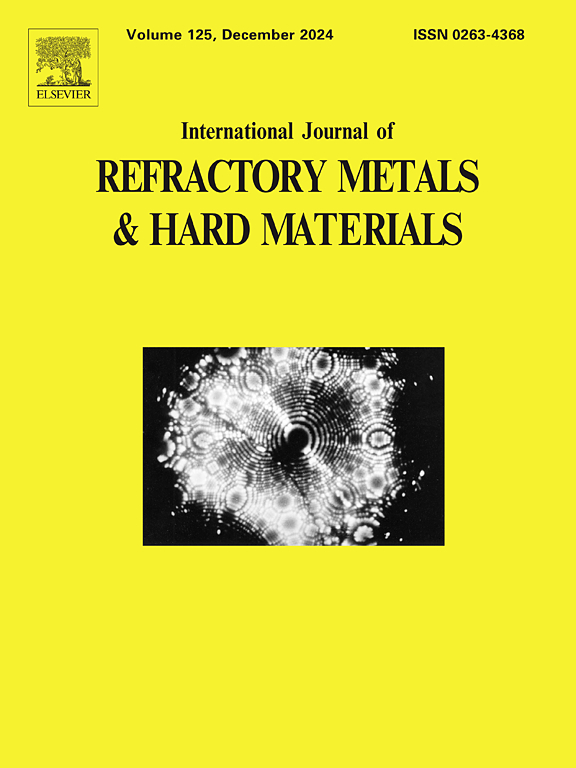Enhancing comprehensive properties of W/Cu joints through surface grinding and spark plasma sintering
IF 4.2
2区 材料科学
Q2 MATERIALS SCIENCE, MULTIDISCIPLINARY
International Journal of Refractory Metals & Hard Materials
Pub Date : 2025-03-22
DOI:10.1016/j.ijrmhm.2025.107160
引用次数: 0
Abstract
To address the challenges in joining immiscible W/Cu dissimilar metals, this study employs surface grinding to induce plastic deformation and coarsening on the W surface, thereby obtaining the reliable W/Cu joints through spark plasma sintering (SPS). The effects of surface grinding and bonding temperature on the interfacial microstructure, mechanical properties and thermal conductivity of W/Cu joints were systematically investigated. The results demonstrate that the micro-nano structure on the W surface is successfully introduced into the W/Cu interface via surface grinding combined with SPS, forming a serrated interface structure. Shear tests and fracture analysis reveal that this serrated interface structure effectively enhances the mechanical interlocking effect and changes the crack propagation path, thus improving the mechanical properties of W/Cu joints. At 1000 °C, the shear strength of the W/Cu joint after surface grinding reaches 214.17 MPa, which is 55.59 % higher than that of the joint prepared through direct bonding (DB). Furthermore, compared to the DB joint, the W/Cu joint after surface grinding maintains superior high-temperature thermal conductivity, which is 130.11 W/(m·K) at 600 °C. This work proposes a simple and effective mechanical surface treatment method to realize high-performance W/Cu joints.
通过表面磨削和火花等离子烧结提高钨铜接头的综合性能
为了解决不相混相W/Cu异种金属连接的难题,本研究采用表面磨削诱导W表面的塑性变形和粗化,从而通过火花等离子烧结(SPS)获得可靠的W/Cu连接。系统研究了表面磨削和结合温度对W/Cu接头界面组织、力学性能和导热系数的影响。结果表明:通过表面磨削结合SPS, W表面的微纳结构被成功引入到W/Cu界面中,形成锯齿状界面结构;剪切试验和断裂分析表明,这种锯齿状界面结构有效地增强了力学联锁效应,改变了裂纹扩展路径,从而改善了钨铜接头的力学性能。在1000℃时,表面磨削后的W/Cu接头抗剪强度达到214.17 MPa,比直接结合(DB)制备的接头抗剪强度提高55.59%。此外,与DB接头相比,表面磨削后的W/Cu接头在600℃时的高温导热系数为130.11 W/(m·K)。本工作提出了一种简单有效的机械表面处理方法来实现高性能钨铜接头。
本文章由计算机程序翻译,如有差异,请以英文原文为准。
求助全文
约1分钟内获得全文
求助全文
来源期刊
CiteScore
7.00
自引率
13.90%
发文量
236
审稿时长
35 days
期刊介绍:
The International Journal of Refractory Metals and Hard Materials (IJRMHM) publishes original research articles concerned with all aspects of refractory metals and hard materials. Refractory metals are defined as metals with melting points higher than 1800 °C. These are tungsten, molybdenum, chromium, tantalum, niobium, hafnium, and rhenium, as well as many compounds and alloys based thereupon. Hard materials that are included in the scope of this journal are defined as materials with hardness values higher than 1000 kg/mm2, primarily intended for applications as manufacturing tools or wear resistant components in mechanical systems. Thus they encompass carbides, nitrides and borides of metals, and related compounds. A special focus of this journal is put on the family of hardmetals, which is also known as cemented tungsten carbide, and cermets which are based on titanium carbide and carbonitrides with or without a metal binder. Ceramics and superhard materials including diamond and cubic boron nitride may also be accepted provided the subject material is presented as hard materials as defined above.

 求助内容:
求助内容: 应助结果提醒方式:
应助结果提醒方式:


